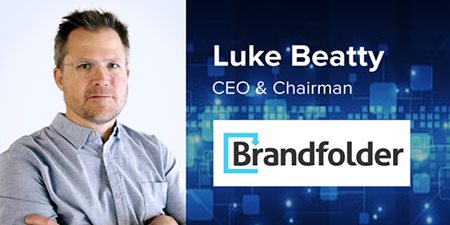Brandfolder Offers New Brand Intelligence Features for DAM
By Natalie Evans
March 21, 2019
Asset, Brand, Brandfolder, Branding, Cloud, content, DAM, Digital, Growth, Management, marketing, Personal, SaaS, storage, Strategy
In 2018, the digital asset management (DAM) market experienced a growth explosion. According to Zion Market Research, the global DAM market is estimated to reach $8.1 billion by the end of 2024. Advancements in technology have shaped much of the digital world and have also transformed DAM. The use of AI, in particular, has made its mark on DAM solutions, including automation in tagging and generating metadata for images and videos.
Many companies in this industry have introduced enhanced solutions offering capabilities such as storage and retrieval, AI-driven search, managing rights and identities, and related functionalities. Brandfolder is one of those companies and they recently just launched new features to their ‘Brandfolder Brand Intelligence’. I reached out to Luke Beatty, CEO, and Chairman of Brandfolder, to explain how these new features will benefit one’s strategy, along with what makes the Brandfolder’s platform stand out in such a fragmented market. I also asked Luke to share his thoughts about the future evolution of DAM.
Could you please explain how “Brandfolder Brand Intelligence” features will benefit one’s creative strategy and development, and why?
Brandfolder Brand Intelligence informs strategy at the three central stages of the branding process; creation/ development, distribution, and performance analysis. For one, we provide brands with context and insights about their creative and their candidate creative. We equip our Brand Intelligence users with data around things like compliance, consistency calculations, and uniqueness scoring upon ingestion. Once brand creative is firmly assigned to a Brandfolder, we provide intelligence around distribution, connectivity, consumption, and integration points. This helps brand leaders understand where exactly their brand creative is being implemented, and master the toggles of control to drive exact, desired usage by both people and platforms. Lastly, our data science team, led by Ajay Rajasekharan, has been constructing and filing IP around brand asset scoring and probability. This level analyzes live and candidate brand creative while analyzing and predicting and collecting the performance of brand creative across omnichannel distribution points like social, e-commerce, email, etc.”
The press release mentions that “Brandfolder, which has doubled in revenue for three consecutive years, is a leader in DAM. The global DAM market is expected to reach $8.1 billion by 2024, according to a recent Zion Market Research report.” How does Brandfolder differentiate itself from the rest in the DAM landscape?
“Brandfolder's differentiation is centered squarely on a brand engagement ROI. Most of the traditional DAM competitive set is focused on cloud storage and filing benefits or time saved. Those value props go without saying. Our ROI is brand lift—or brand performance. Marketers develop creative to grow brand, not to have it filed and classified correctly. We are also known for having the most modern, intuitive, elegant modular platform that works for the Fortune 500 as well as smaller boutique brands. We retain over 95% of our customer base because marketers see higher levels of brand engagement, radically improved brand consistency, and the ability to execute data-driven dynamic branding. As an analogy, a CRM helps store, manage, and classify customers, sure, but what it really does is provide a sales organization with intelligence so that it can make better decisions and better serve customers and prospects.”
There has been a lot of growth in the DAM industry. How do you see the future evolution of DAM platforms?
"I think the evolution is driven by brands moving their brand assets out of commoditized, featureless cloud storage like Dropbox, Google Drive, and Box. Creative leaders want feature-rich tools, integrations to other platforms that traffic in creative and, in our case, intelligence to support brand decisions. The growth of the market is due to a few things from an organic perspective as well. Brands are everywhere today. Individuals have brands, and most businesses have many dynamic brands. This is compounded by, one, the explosion of endless new format types like podcasts, 3d files, etc., and two, the growth of new endpoints in an omnichannel marketing world.”
In a previous piece, my colleague, Gabriella Pirrone, connected with Luke to discuss “The Importance of Brand Strategy in Relation to DAM”. The article will give you a greater understanding of how brand strategy and DAM work together along with providing insight into the qualities one should seek when selecting a DAM platform.
New Board Member
Brandfolder also welcomed the appointment of Tim Armstrong to the Board of Directors. He will be joining Mickey Arabelovic, Steve Baker, Luke Beatty, and Robert Zak on the Board. Armstrong, the former Google Ads Chief, and AOL CEO, recently founded the dtx company. Armstrong’s experience in the global brand realm supports Brandfolder’s ideals, as it develops creative asset analytics and intelligence offerings.
“‘Brand’ is one of the most defining assets for any company, anywhere in the world. Brandfolder is unique in its approach to empower and inform companies as they build dynamic brands,” said Armstrong. “I am thrilled to join the Board of Brandfolder knowing that thousands of top global brands leverage the company's innovative brand creative management platform.”
“Tim joins the Brandfolder Board at an exciting time as we continue to evolve our abilities to manage brand distribution logistics while providing actionable, never-before-seen intelligence that drives increased brand engagement,” said Beatty. “He has led some of the biggest B2B and B2C brands in the world and understands the value of a data-driven DAM like Brandfolder. I am confident Tim will make a positive impact on our company.”
Ending Notes
DAM has become more than just an asset management platform. Since its inception, you can see how these platforms have grown. 2018 included many new market entrants with growth at all levels; small, mid-market, and enterprise. This growth was driven by the focus on customer experience and personalization, and increased demand to create, contribute, and use richer content.
With DAM touching upon so many different departments within an organization, the need for a more intelligent platform is now required. Brandfolder’s new features with ‘Brand Intelligence’ is making the DAM platform more robust, and a requirement in one’s organization.

Natalie Evans
Natalie Evans has over 16-years in the tech industry and currently works as the event coordinator and tech reporter for CMS-Connected, keeping up-to-date on what's happening in and around the Content Management industry.